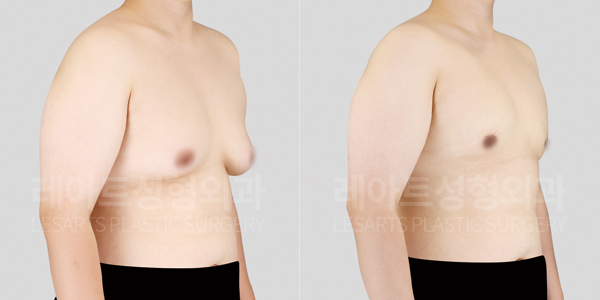Simon Grade 3, Difference Before and After Gynecomastia Surgery

Information
- Age : mid 20’s
- Height : 176cm
- Weight : 100kg
- BMI : 32
Surgical site
- surgical site : gynecomastia
- grade : 3
Some patients may require additional correction after gynecomastia surgery following a post-operative assessment.
While this is not a common occurrence, we thoroughly evaluate factors such as the severity of gynecomastia, the degree of skin sagging, and the potential for tissue changes after surgery to help patients understand the possibility of further adjustments, such as skin tightening or shape correction.
Rather than rushing into revision surgery, it is crucial to allow sufficient time for tissue recovery after gynecomastia surgery. Monitoring the progress carefully and implementing necessary procedures and treatments can help achieve a more natural and well-balanced chest contour.
Now, let’s analyze the pre- and post-operative photos of the patient below to examine the changes in chest shape following gynecomastia surgery in detail.

[Lesarts plastic surgery before gynecomastia surgery]
This patient is a man in his 20s who became aware of his gynecomastia symptoms after reaching adulthood.
In recent years, he experienced moderate weight gain, which made the enlargement of his chest more noticeable.
To reduce his chest size, he consistently engaged in aerobic exercise, but despite his efforts, there was no change in the shape or size of his chest, causing significant stress.
Additionally, as his areolas enlarged, his chest took on a more protruding appearance, further intensifying both his physical discomfort and psychological distress.
Ultimately, he decided to undergo gynecomastia surgery to address the underlying issue and visited our clinic for treatment.

[Lesarts plastic surgery before gynecomastia surgery]
Before proceeding with the consultation, we conducted a visual assessment of the patient’s chest condition.
It was evident that his chest size had significantly increased, and given his larger body frame, the volume of his chest appeared even more prominent.
To obtain a precise diagnosis, we performed an ultrasound examination, which confirmed the presence of glandular hypertrophy.
Based on the findings, our medical team diagnosed the patient with true gynecomastia, classified as Simon Grade 3.
We explained to the patient that in such cases, general weight management, exercise, or liposuction alone would not be sufficient to reduce the chest size effectively.
Therefore, we devised a surgical plan that involved the precise removal of excessively developed glandular tissue to fully eliminate the underlying cause of chest enlargement. Additionally, we planned to perform tissue repositioning surgery to ensure a natural chest shape and maintain skin elasticity after the procedure.
Considering the patient’s body type and Simon Grade 3 classification, we emphasized the importance of postoperative care for a smooth recovery. This included wearing a compression garment, applying cold or warm compresses, moisturizing the skin, and attending regular follow-up appointments to monitor progress.
Below is a comparison of the patient’s chest before surgery and nine months after the procedure.

[Lesarts plastic surgery before&after gynecomastia surgery(Taken under the same conditions 9 months after gynecomastia surgery.)]

[Lesarts plastic surgery before&after gynecomastia surgery(Taken under the same conditions 9 months after gynecomastia surgery.)]
When examining the patient’s preoperative photos, we can see that glandular hypertrophy caused the overall chest to protrude. Additionally, the right nipple was inverted, giving an unnatural appearance.
However, after gynecomastia surgery, the previously protruding chest was completely corrected, resulting in a flat and natural chest contour.
Moreover, through tissue repositioning surgery, both the areolar protrusion and inverted nipple were successfully corrected, creating a balanced and masculine chest shape.

[9 month post-gynecomastia progress(Image for better understanding.)]

[9 month post-gynecomastia progress(Image for better understanding.)]
The difference in appearance before and after surgery is clearly noticeable, even when wearing a white T-shirt.
Before gynecomastia surgery, the excessive chest volume and protrusion of the areolas caused discomfort, as the chest contours were very prominent under clothing. However, after surgery, the significant reduction in chest volume resulted in a cleaner and more natural fit, greatly improving the overall appearance.
Additionally, the previously raised shape near the outer chest and the inverted nipple were corrected, creating a well-balanced chest contour. This transformation contributed to a more confident and self-assured look.
However, since the patient had Simon Grade 3 gynecomastia with excessively developed glandular tissue, continuous post-surgical monitoring was necessary.
Moreover, due to the wide excision of glandular tissue, it was important to observe the formation of scar tissue. The patient fully understood these aspects and actively participated in follow-up care and treatments, resulting in a stable recovery by the ninth month post-surgery.
Additionally, since the patient was taking hair loss medications (finasteride and dutasteride), there was a risk of gynecomastia recurrence due to hormonal changes. This was another key factor to monitor.
We emphasized that maintaining the results of gynecomastia surgery requires more than just the surgical procedure itself. Long-term follow-up care and lifestyle management are crucial for ensuring sustained results.